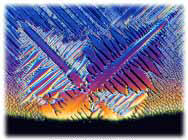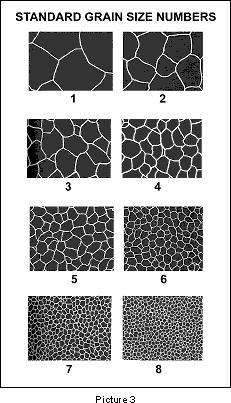 |
|
| Crystals, grains, and cooling |
 Picture 1 - Dendrite crystal Crystals As molten steel begins to cool, the lattice structures begin to attach to one another and form crystal skeletons called dendrites, which resemble the look of a pine tree. Dendrites start to form everywhere, and each one continues to grow independently. This is the beginning of the transformation to a solid state. See Picture 1.
The space that exits between grains, usually just a few atoms wide, is referred to as a grain boundary. See picture 2.
Cooling rate If molten steel is cooled slowly, dendrites have a longer time to grow before they begin to bump into neighboring dendrites. Thus, a large grain size is formed. When steel is cooled quickly, the number of dendrites that begin growing increases, and the dendrites form quickly and begin to be restricted by other dendrites. Smaller grain size is the result. |


